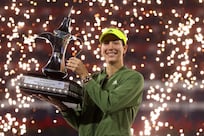As its title implies, Peter Carey's excellent novel The Chemistry of Tears takes as its starting point the supposed divide between the rational (chemistry) and the irrational (tears). The plot concerns a marvel of engineering, an elaborate 19th century clockwork swan.
Through the story of the swan the novel investigates emotions whose power it thinks of as exceeding the limits of rational understanding: love and grief. Today, we imagine that there is a clear line between "hard" subjects - science, technology, engineering and mathematics, and "soft" ones - religion, the humanities and the like. The hard subjects are precise, logical and useful; the soft ones fuzzy, emotional and "ornamental" (to use the former British secretary of state for education Charles Clarke's controversial term).
It is easy to forget that the relationship between, on the one hand, science, and on the other, art, religion and even mysticism, was once much closer than it is today. Figures whose lives combined the rational and the irrational abounded in the 18th and 19th centuries, such as the fundamentalist preacher and marine biologist Theophilus Hopkins who features in Carey's 1988 novel Oscar and Lucinda. The term "scientist" was coined at a debate in which Samuel Taylor Coleridge, poet and "natural philosopher," was a participant. Isaac Newton was a dedicated alchemist.
The Chemistry of Tears switches back and forth between two plots, both of which deal with similar themes. A plot set in 2010 involves the grief-stricken museum curator, Catherine Gehrig, who is asked to rebuild the swan by an ostensibly kindly colleague - though Catherine is so suspicious of his motives that we are never quite sure - in order to provide her with the isolation necessary for her to grieve secretly over the death of Matthew, her long-time married lover, and at the same time keep her job. A second, historical, narrative unfolds in the pages of a set of journals accompanying the components of the swan.
Here, in 1854, Henry Brandling records the story of his bizarre journey from England to Germany in order to have the automaton constructed for his consumptive son Percy.
The rational and the irrational overlap at every turn. Sometimes these overlaps feel safe and relatively comprehensible: the scientific process of reconstructing the swan helps Catherine transform her grief at her lover's death from something overwhelming and dangerous into something tragic but manageable. When, at the end of the book, she writes: "I love you. I hold you. I miss you forever," we understand these words as a farewell to the man she has spent the novel desperately unwilling to release. The mechanical swan moves the museum's bean-counting investors to wonder, inducing a "sense of awe […] in men you might have thought beyond all human feeling." Henry Brandling believes that his son's "elevated form of curiosity or desire" for a mechanical duck will affect his spirits with "magnetic agitation" and thus cure his tuberculosis. All of this is likely to make sense to readers, even if we don't believe that an automaton could cure consumption.
At other times, however, such overlaps feel disturbing, uncanny, and dangerous. Sumper, the German engineer who manufactures a mythic swan instead of the comic duck Henry requests, believes that mechanical engineering provides humankind with a way to access "mechanisms beyond human knowledge", "systems we could never know". He refers to such knowledge as the "Mysterium Tremendum", "the awe and wonder of the universe".
Catherine's assistant Amanda believes that part of the swan's clockwork mechanism had originally been built to smuggle parts of the first combustion engine out of Germany, a machine she believes to have been inspired by some unknown intelligence in order to destroy human life. She believes that the Deepwater oil spill in the Gulf of Mexico, footage of which Amanda watches obsessively on what she calls her "Frankenpod," is proof of this centuries-long extraterrestrial conspiracy.
The novel's style works to reinforce in its readers this sense of being unmoored and unsafe. Carey's work has often been compared to that of Charles Dickens, not only because his 1997 novel Jack Maggs is a reworking of Dickens's Great Expectations, but also because, as in his The True History of the Kelly Gang or Oscar and Lucinda, he frequently populates an epic national landscape with a host of eccentric or comic characters.
However, despite its pan-European, epoch-spanning plot, the Chemistry of Tears is characterised by a highly un-Dickensian feeling of claustrophobia. It takes place in little London flats, museum work rooms locked away behind barbed-wire security fences and tiny inn guest-rooms. We see its small cast relentlessly through the narrow perspectives of the two central characters. Both Henry's and Catherine's chapters are written in the first person, and both characters are unreliable narrators: her perceptions distorted by her wild grief, Catherine alienates everyone around her. She swigs vodka until she passes out and awakes with bruises of mysterious provenance, and steals priceless elements of the automaton, as well as Henry's journals. Henry's understanding of events is likewise bent out of shape by the ferocity of his desire to save his son, to the extent that even some of the basic events of his story are unclear. Chunks of his narrative are missing - Catherine destroys one of his notebooks, and additional parts of his story have been misrepresented or left unwritten.
We never discover, for instance, whether or not the swan works its wonders on Percy Brandling. Catherine describes reading his notes as looking "through a glass darkly" at a narrative whose details "would never be clarified." As readers, our confusion is compounded as the novel introduces chapters narrated by "Henry & Catherine," in which Catherine edits and annotates those elements of Henry's journal she permits us to see, and thus doubles our sense that what we read is being viewed through a distorting lens. In the midst of worlds populated by mystics and fantasists, neither central character functions for the reader as an anchor to reliable sense.
If Catherine and Henry are unreliable, however, they, as well as the novel's other characters, are also wonderfully real. Catherine's descriptions of Matthew's belongings - "his silly soft tweed hat", for instance - economically evoke the intimacy between the couple. The tender relationship between Henry and Percy is likewise deftly drawn in brief snapshots of the two planning their imaginary "Adventures of the Two True Friends" or delightedly discovering "the design for M. Vaucanson's ingenious duck" with "a great shout." Carey has a way with detail that brings his characters to life.
In addition, although The Chemistry of Tears's world might feel small, its ambition is considerable. Elements of the plot sometimes resemble a novel like The Da Vinci Code. However, that is where such comparisons begin and end. In The Da Vinci Code readers have a holiday romance with the mysterium tremendum, in a sublime unknown land of mysticism, magic and conspiracy, but at the end of that novel our fling comes to a tidy conclusion as mysteries are unravelled, villains caught, and science and logic explain it all.
By contrast, in The Chemistry of Tears, the supposedly firm and logical terrain of science is itself the mysterium tremendum. Engineering is something we reach for when we find ourselves lost in uncharted emotional territory: when love persuades us that a mechanical duck will save our son; when grief makes us steal our lover's belongings, drink vodka for lunch, and reconstruct a complex 19th century automaton; when ambition drives us to design a machine that will unravel the mystic truths of the universe. Very little about The Chemistry of Tears is tidy. The final revelation that gives the novel its sense of closure - that Carl, the child who lives with Herr Sumper, might in fact be Karl Benz, inventor of the motor car - is deeply ironic; it is the baseless conjecture of Amanda, who also believes the combustion engine to have been invented by nonhuman "fabulous beings".
Carey does not even allow us the security of scepticism. Amanda might be crazy, Catherine thinks, or she could be a "genius". The swan might have restored Percy to health, or it might not. The appeal of science might lie in its promise to solve the world's most difficult problems, but Carey's achievement with The Chemistry of Tears is, by means of a story about science, to depict our most taxing problems in their full insolubility.
Tom Perrin is an assistant professor of language and literature at Huntingdon College. He has written for The National and the Times Literary Supplement.










